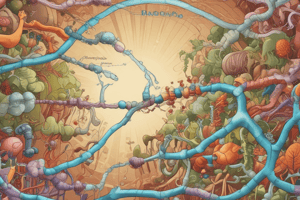Podcast
Questions and Answers
¿Por qué la creatina quinasa (CK) es importante en el diagnóstico de enfermedades?
¿Por qué la creatina quinasa (CK) es importante en el diagnóstico de enfermedades?
La CK es importante en el diagnóstico de enfermedades porque existen dos tipos principales de CK: CK-MB y CK-MM, que pueden indicar daño muscular, siendo CK-MB específico para infarto de miocardio por su predominancia en el tejido cardíaco.
¿Qué son las isoenzimas y por qué son importantes en el diagnóstico de patologías?
¿Qué son las isoenzimas y por qué son importantes en el diagnóstico de patologías?
Las isoenzimas son formas múltiples de una enzima individual que difieren ligeramente pero comparten una función común. Son importantes en el diagnóstico de patologías porque pueden servir como marcadores para detectar enfermedades específicas.
¿Por qué son importantes las isoenzimas de la lactato deshidrogenasa (LDH) en el diagnóstico de infarto de miocardio?
¿Por qué son importantes las isoenzimas de la lactato deshidrogenasa (LDH) en el diagnóstico de infarto de miocardio?
Las isoenzimas de LDH, LDH-1 y LDH-2, son importantes en el diagnóstico de infarto de miocardio porque sus niveles en muestras de sangre son más altos después de un infarto de miocardio que en individuos sanos.
¿Cómo pueden los niveles de aspartato aminotransferasa (AST) reflejar daño hepático en el cuerpo?
¿Cómo pueden los niveles de aspartato aminotransferasa (AST) reflejar daño hepático en el cuerpo?
¿Cuál es el papel de las lipasas en el diagnóstico de patologías? ¿Y qué condiciones pueden afectar su actividad?
¿Cuál es el papel de las lipasas en el diagnóstico de patologías? ¿Y qué condiciones pueden afectar su actividad?
Flashcards are hidden until you start studying
Study Notes
Enzymes
Enzymes play a crucial role in clinical diagnosis and treatment. They are biological molecules that speed up chemical reactions without being consumed by them, enabling cellular processes such as digestion, absorption, respiration, exercise, and reproduction. Understanding enzymes is essential for understanding how cells function.
Inhibitors of Enzymatic Activity
Inhibitors can regulate enzymatic activity. These compounds bind to enzymes, reducing their ability to perform their functions. Inhibitors can be used therapeutically to reduce enzyme activity in certain conditions. For example, aspirin reduces platelet aggregation through its effect on cyclooxygenase, which ultimately helps prevent blood clots. Other inhibitors like statins block the HMG-CoA reductase enzyme, lowering cholesterol levels [1, 2].
Regulation of Enzymatic Activity
Enzyme activity can be regulated at multiple levels:
-
Transcriptional regulation: Genetic factors control whether genes encoding specific enzymes are transcribed into mRNA. Some enzymes are made only when needed under specific conditions.
-
Posttranslational modifications: Once synthesized, enzymes may undergo changes in structure that alter their activity. These modifications can be reversible, allowing the enzyme to change its behavior in response to different signals.
-
Allosteric regulation: Some enzymes have multiple binding sites, allowing them to be influenced by other molecules. These interactions can either activate or inhibit the enzyme's activity.
Isozymes in Diagnosis of Pathologies
Isoenzymes are multiple forms of an individual enzyme that differ slightly but share a common function. They are produced from different genes within the same gene family and may vary depending on tissue type. For example, isoenzymes of lactate dehydrogenase (LDH) are important markers for diagnosing myocardial infarction: LDH-1 and LDH-2 levels in blood samples are higher after myocardial infarction than in healthy individuals.
Other common isozymes used in clinical diagnosis include:
-
Creatine kinase (CK): Two main types of creatine kinase exist: CK-MB (muscle-brain) and CK-MM (muscle-muscle). Both forms can indicate muscle damage, but CK-MB specifically indicates myocardial infarction because it is predominantly found in heart tissue.
-
Lipases: These enzymes play a role in digesting dietary lipids. In the context of diseases, lipase activity may increase due to pancreatitis or inflammation affecting fat metabolism.
-
Aspartate amino transferase (AST): Another liver enzyme, AST levels can reflect hepatocytes damage caused by various conditions such as viral infection, hepatic necrosis, or drug toxicity.
A comprehensive panel of enzymes allows medical professionals to diagnose various diseases more accurately by assessing the enzyme levels and their specific isozymes.
Studying That Suits You
Use AI to generate personalized quizzes and flashcards to suit your learning preferences.




